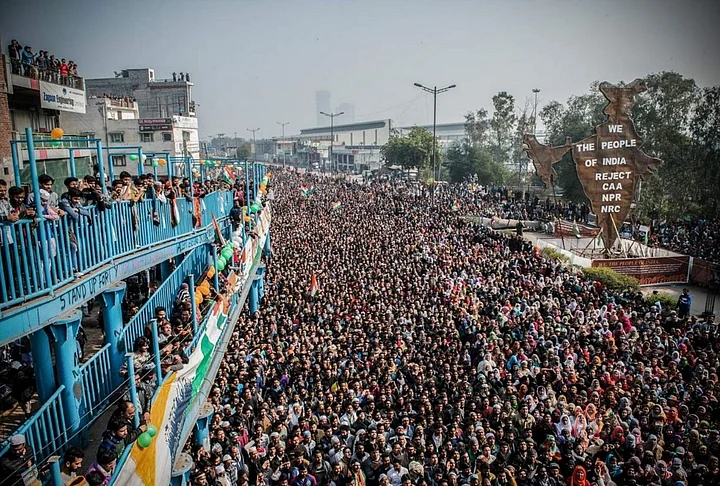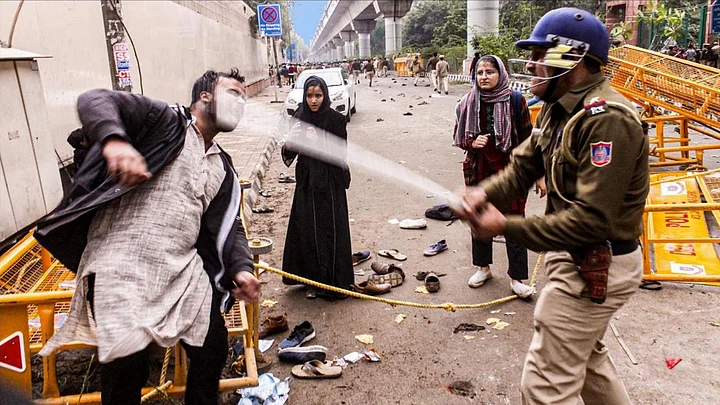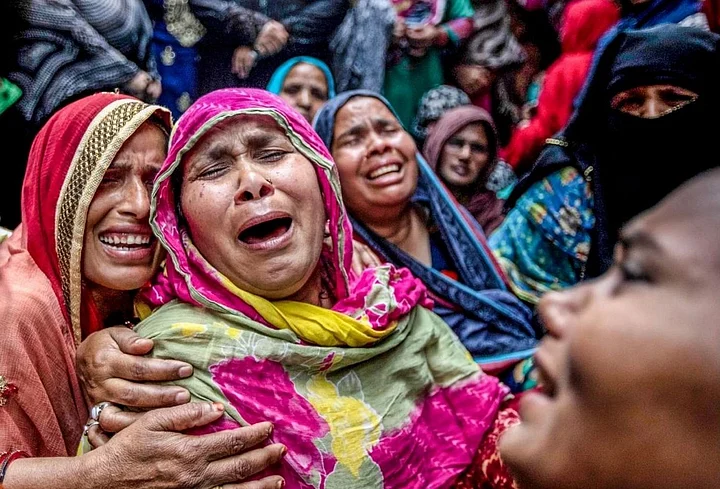In December 2019, the passing of the controversial Citizenship Amendment Act sparked off massive protests across the country, with the fountainhead of the agitation being a women-led sit-in protest at Shaheen Bagh, in the heart of the national capital.
Over the three months that followed, Delhi was in deep and almost constant turmoil. From violence at universities like Jamia Millia Islamia and JNU, to the state's efforts to clamp down on the burgeoning protests, from Hindutva extremists opening fire outside protest sites, to the riots that scourged northeast Delhi in February 2020, those were three months that shook the capital.
- 01/04
A student being beaten up by a policeman during the anti-CAA/NRC protest
(Photo: Shivam Khanna)

- 02/04
Shadab, a student at Jamia, was injured by a bullet shot at him outside the Jamia campus.
(Photo: Md Meharban)

- 03/04
An injured Shadab climbs over the barricades to make his way towards the Holy Family Hospital, New Delhi
(Photo: Md Meharban)

- 04/04
A group of people looking at the remains of the torched-up vehicles at a parking lot in New Delhi's Mustafabad.
(Photo: Md Meharban)

'Hum Dekhenge', a recently published photobook by research scholar Aasif Mujtaba and photojournalist Md Meharban, documents that troubled period in graphic detail. The following is a selection of pictures from the book, accompanied by excerpts written by Md Meharban.
The Truth - Through Our Lens
Born in December 2019 in the corridors of a vilified university and sustained by the streets of an infamous ghetto in Delhi, the anti-CAA movement was the strongest opposition faced by Narendra Modi and his government since coming to power in May 2014.
- 01/03
31 December 2019: Protesters holding the Indian flag at the anti-CAA protest at Jamia Millia Islamia
(Photo: Mayank Makhija)

- 02/03
26 January 2020: On Republic Day, thousands of people assembled at the Shaheen Bagh protest site to voice their dissent against CAA/NRC
(Photo: Mahavir Singh Bisht)

- 03/03
Protesters appealing for love instead of bullets at the Jafrabad protest site in Delhi
(Photo: Md Meharban)

Photographs, Attacks and Nightmares
I have personally endured violence during the protests. My camera was confiscated and stomped at by the Delhi Police, who wished to get rid of the footage proving their indiscriminate use of force against unarmed children behind the parked cars in Daryaganj, Delhi.
I've been violently charged at and manhandled, leaving me with nightmares for months to come. What I went through pales in comparison with the ordeal of the people of northeast Delhi during and in the aftermath of the Delhi Pogrom of 2020.
- 01/03
13 December 2019: Framed in action - Delhi Police personnel pelting stones at the protesters outside Jamia campus
(Photo: Sreekanth Sivadasan)

- 02/03
13 December 2019: Delhi Police raining blows at a student protester outside Jamia Millia Islamia
(Photo: Md Meharban)

- 03/03
13 December 2019: A policeman pelting stones at the students of Jamia Millia Islamia
(Photo: Sreekanth Sivadasan)

The Power of Pictures
I've always believed that photos are powerful. They capture and express the emotions and have the power to move us. That's why in mid-February 2020, I put up an exhibition of the photos I had taken of the CAA protests at Gate No. 11 of Jamia Millia Islamia.
People would come to the exhibition each day and make videos of my exhibition. One morning, while I was sitting under the metro pillar at the university. I saw three burqa-clad women standing in front of my exhibition. Suddenly, they crossed the rope I had placed in front of it, fell on their knees and started sobbing. I got up and rushed to them. I heard one of the woman saying, "Humein pata nahi tha itni berehmi se baccho ko maara tha (I didn't know our children were beaten this mercilessly)."
At that moment, I realised the impact my photos from that time could have on people's understanding of that powerful movement. That's the story of the conception of this photo book.
We Will Remember, We Must Remember
- 01/04
Family members mourn Muddasir Khan, a victim of the violence in northeast Delhi.
(Photo: Adnan Abidi/Reuters)

- 02/04
The mother of 17-year-old Mohammad Hashim and 23-year-old Mohammad Amir cries helplessly after her sons are killed by a Hindu mob
(Photo: Vijay Pandey)

- 03/04
23 February 2020: A violent mob attacking a Muslim man
(Photo: Danish Siddiqui/Reuters)

- 04/04
24 February 2020: A woman waiting outside the GTB Hospital in the aftermath of the violence
(Photo: Mahavir Singh Bisht)

Hum Dekhenge is an attempt to dig beneath the lies and propaganda to present key events from the anti-CAA movement and the Delhi pogrom. The idea was to preserve the memory of pain, suffering, resistance, hopelessness, solidarity, joy, anger and other emotions people went through from 12 December 2019 to 23 March 2020.
Hum Dekhenge is a manifestation of the promise made by every oppressed to the oppressor - a promise to not forget. It is a testament to the enduring power of truth and a hope for the deliverance of that timeless justice assured to all people in all ages.
- 01/04
Families trying to find their 'normal' in temporary relief camps after their homes in northeast Delhi were gutted down
(Photo: Rehan Khan)

- 02/04
Mohammad Wakeel (left) lost his vision after facing an acid attack by a Hindu mob and Mohammad Nasir Khan (right) lost his left eye to a gunshot
(Photo: Md Meharban)

- 03/04
A mother and her son sitting outside their vandalised house in Shiv Vihar, Delhi
(Photo: Rehan Khan)

- 04/04
Portraits of young children whose lives were disrupted by the violence
(Photo: Md Meharban)



















